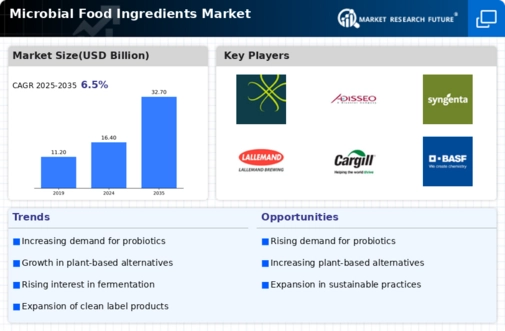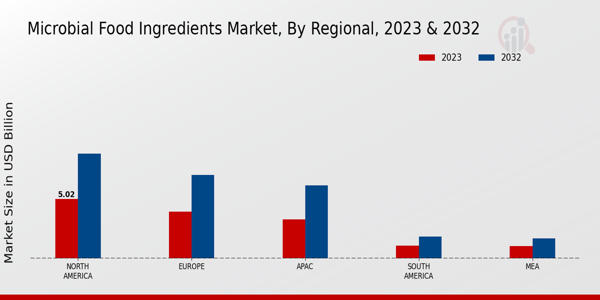Market Growth Projections
The Global Microbial Food Ingredients Market Industry is poised for substantial growth, with projections indicating a market value of 16.4 USD Billion in 2024 and an anticipated increase to 32.7 USD Billion by 2035. This growth trajectory suggests a compound annual growth rate (CAGR) of 6.52% from 2025 to 2035, reflecting the increasing adoption of microbial ingredients across various food sectors. The market dynamics are influenced by factors such as consumer preferences for health-oriented products, technological advancements, and sustainability initiatives.
Health Benefits of Probiotics
Probiotics, a key segment within the Global Microbial Food Ingredients Market Industry, are recognized for their numerous health benefits, including improved gut health and enhanced immune function. The increasing prevalence of digestive disorders and a growing focus on preventive healthcare are propelling the demand for probiotic-rich foods. This trend is likely to contribute to the market's expansion, as consumers seek functional foods that offer health advantages. The market is expected to reach 32.7 USD Billion by 2035, reflecting the rising consumer inclination towards health-promoting ingredients.
Expansion of Plant-Based Diets
The rise of plant-based diets is reshaping the Global Microbial Food Ingredients Market Industry. As more consumers adopt vegetarian and vegan lifestyles, there is a heightened demand for microbial ingredients that can enhance the nutritional profile of plant-based foods. Ingredients such as yeast extracts and fermented plant proteins are gaining popularity for their ability to provide flavor, texture, and nutritional benefits. This trend is expected to drive market growth, as the industry adapts to meet the needs of a diverse consumer base seeking plant-based alternatives.
Rising Demand for Natural Ingredients
The Global Microbial Food Ingredients Market Industry is witnessing a pronounced shift towards natural and clean-label products. Consumers increasingly prefer food items that are free from artificial additives and preservatives. This trend is driven by heightened awareness of health and wellness, as well as a desire for transparency in food sourcing. As a result, microbial food ingredients, which are derived from natural sources, are gaining traction. This shift is reflected in the market's projected growth, with an estimated value of 16.4 USD Billion in 2024, indicating a robust demand for these ingredients in various food applications.
Sustainability and Environmental Concerns
Sustainability is becoming a pivotal driver in the Global Microbial Food Ingredients Market Industry. Consumers are increasingly concerned about the environmental impact of food production, leading to a preference for sustainable sourcing and production methods. Microbial food ingredients, often produced through eco-friendly processes, align with these consumer values. This growing emphasis on sustainability is likely to bolster market growth, as companies that prioritize environmentally responsible practices may gain a competitive edge. The alignment of microbial ingredients with sustainability goals positions the industry favorably in the evolving food landscape.
Technological Advancements in Fermentation
Innovations in fermentation technology are significantly influencing the Global Microbial Food Ingredients Market Industry. Advanced fermentation techniques enhance the efficiency and yield of microbial ingredients, making them more accessible and cost-effective. These advancements allow for the production of a diverse range of flavors and textures in food products, catering to evolving consumer preferences. As the industry embraces these technologies, it is likely to witness accelerated growth, with a projected CAGR of 6.52% from 2025 to 2035, indicating a promising future for microbial food ingredients.




















Leave a Comment